One of the relatively new trees in my garden is a Japanese flowering quince ‘chojubai.’ As I purchased the tree from Boon bare-root, I’ve mainly focused on letting the tree gain vigor. Toward this end, I’ve been watering, feeding and removing flowers and flower buds when I can.
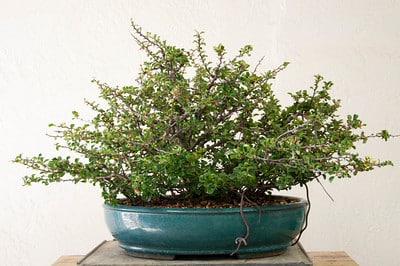
Japanese flowering quince ‘chojubai’
Like many chojubai, mine blooms a bit all year round, making the removal of flowers something of a part-time job. If I don’t remove them in a timely fashion, small fruit appear.
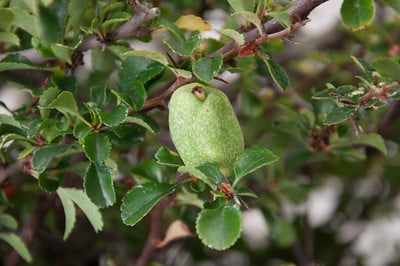
Chojubai fruit
I can’t vouch one way or the other as to whether fruit from Japanese flowering quince have culinary value. After a less than satisfactory experience with unripe princess persimmon, I’m content to let others lead the way.
As the tree has become fairly vigorous, now is a good time for cutback and wiring. It was an excellent time to begin removing the thorns. Thorns are common feature in chojubai, and removing them is a common practice.
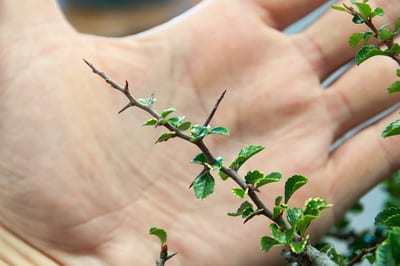
Chojubai thorns
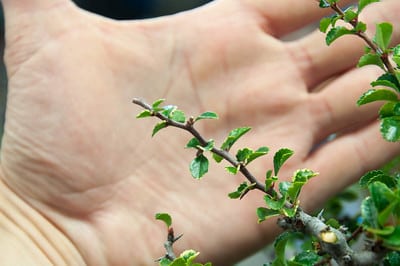
After removing the thorns
As you might imagine, the cutback and thorn removal took a long time. The work was pleasant as it forced me to examine every branch closely which helped me better understand how the tree had grown into its current shape and what might be in store for its future.
Once I got to work, the wiring went relatively quickly. When I was done, the tree started to suggest its future shape.
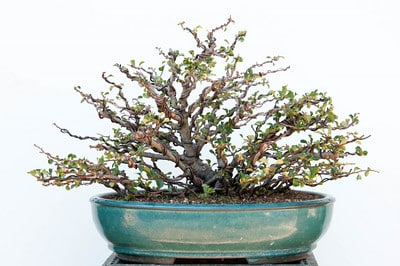
Chojubai – after wiring
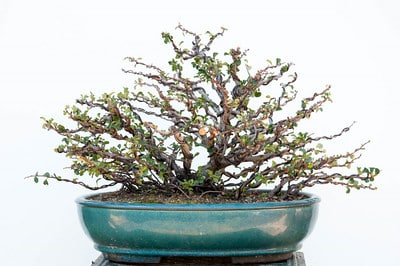
From the back
Within days of the initial cutback, new buds started appearing – both leaf buds and flower buds. I’ll continue to remove the flower buds and encourage all new growth as the main goal at this point is to increase foliage density. I’ll consider repotting the tree in late fall or early spring.
Subscribe to Bonsai Tonight
New Posts Delivered Every Tuesday and Friday
nelibonsai says
Jonas you did not do much of a cut back…any reason?
Jonas Dupuich says
Thanks Neli, that’s a good idea. Altogether I removed somewhere between 1/3 and 1/2 of the foliage:
– I removed some, but not all of the suckers coming up from the soil. I kept the ones that sprouted near the trunk and cut the ones coming up near the edges of the pot.
– I removed 3 or 4 heavy branches as the center of the tree was crowded with heavy branches
– I reduced the size of the tree by several inches by cutting back the longest shoots
– I thinned areas where several branches emerged at the same spot
– I removed branches growing inwards towards the trunk
– I removed a few branches in the front of the tree to reveal the tree’s structure better
– I also thinned clusters of leaves (by removing the outermost leaves) to facilitate wiring
Next time I’ll try to get shots along the way so I can say more about the cutback.
Thanks,
Jonas
nelibonsai says
Thanks Jonas…Dont you cut branches hard back for taper and movement? I thought on chojubai it needs to be done???? Or maybe you do it t different time?
nelibonsai says
Can you elaborate more on cutting back chojubai please. I have not noticed any thorns on my chojubai…wonder if they are there???? Need to check them up.
nelibonsai says
I checked them up…none of my chojubai have thorns????? Can they be some kind of thorn-less variety from Japan?
Jonas Dupuich says
Hi Neli – yes, the more movement and taper the better. This tree has a number of fairly straight branches – over time I’ll likely shorten some of them when I can cut back to better alternatives. The rest I’ll likely leave in place and develop from there. Some nice examples: http://bonsaitonight.com/2014/04/01/chojubai/
nelibonsai says
Thank you Jonas…You did not tell me if there are thorn-less chojubai…or maybe mine are not vigorous enough to develop thorns….
Brian VF says
Looks great Jonas!
Robert Fujimoto says
Jonas is this chojubai for sale?
Sent from my iPhone
>
Jonas Dupuich says
Hi Robert – it’s not for sale. Am curious if anyone knows where one might find somewhat developed chojubai.
Jonas Dupuich says
Hi Neli – While thorns are common in chojubai, not all specimens have them.